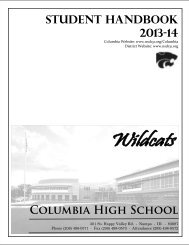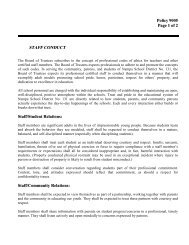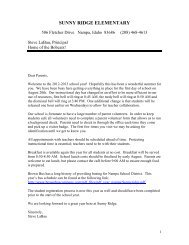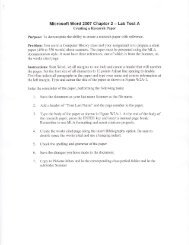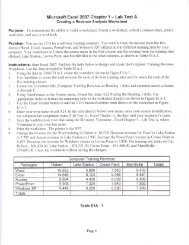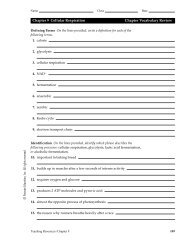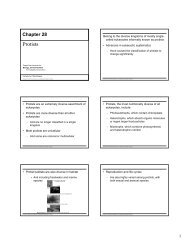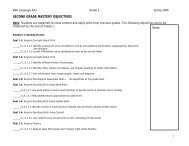crime scene - stuartrossechemistry
crime scene - stuartrossechemistry
crime scene - stuartrossechemistry
Create successful ePaper yourself
Turn your PDF publications into a flip-book with our unique Google optimized e-Paper software.
C R I M ES C E N EForensic Science CC 30.07 Spring 2007 Prof. Nehru
Physical Evidence• Crime laboratories “run” on physical evidence• Physical evidence encompasses any and allobjects that can establish that a <strong>crime</strong> has beencommitted or can provide a link between a<strong>crime</strong> and its victim or a <strong>crime</strong> and itsperpetrator.• But if physical evidence is to be used effectivelyfor aiding the investigator, its presence firstmust be recognized at the <strong>crime</strong> <strong>scene</strong>.Forensic Science CC 30.07 Spring 2007 Prof. Nehru
The Beginning• Forensic science begins at the <strong>crime</strong> <strong>scene</strong>• Every forensic investigator has to recognizephysical evidence and properly preserve itfor laboratory examination ,• Any amount of sophisticated laboratoryinstrumentation or technical expertise cansalvage the situation if physical evidence isnot collected properly.• The techniques of <strong>crime</strong>-<strong>scene</strong> investigationare not difficult to master and certainly liewithin the bounds of comprehension of theaverage police officerForensic Science CC 30.07 Spring 2007 Prof. Nehru
The First Steps -1• The first officer to arrive at the <strong>scene</strong> isresponsible for securing the <strong>crime</strong><strong>scene</strong>.• Priorities should:1. Medical assistance for individuals in need2. Arresting the perpetrator3. Exclude all unauthorized personnel fromthe <strong>scene</strong>.Forensic Science CC 30.07 Spring 2007 Prof. Nehru
The First Steps -2• Once the <strong>scene</strong> is secured, thepreliminary exam must begin• Recording of the <strong>crime</strong> <strong>scene</strong>becomes a critical piece to theinvestigation process.Forensic Science CC 30.07 Spring 2007 Prof. Nehru
Recording Methods• Photography, sketches, and notes are thethree methods for <strong>crime</strong>-<strong>scene</strong> recording• Ideally all three should be employed;however, as is often the case, personneland monetary limitations may prohibit theutilization of someForensic Science CC 30.07 Spring 2007 Prof. Nehru
Photography -1• The most important prerequisite forphotographing a <strong>crime</strong> <strong>scene</strong> is for it to be in anunaltered condition.• Unless there are injured parties involved, objectsmust not be moved until they have beenphotographed from all necessary angles.• As items of physical evidence are discovered,they are photographed to show their positionand location relative to the entire <strong>scene</strong>.Forensic Science CC 30.07 Spring 2007 Prof. Nehru
Photography -2• After these overviews are taken,close-ups should be taken to recordthe details of the object itself.–When the size of an item is ofsignificance, a ruler or othermeasuring scale may be insertednear the object and included in thephotograph as a point of reference.Forensic Science CC 30.07 Spring 2007 Prof. Nehru
Sketches• Next, sketchs of the <strong>scene</strong> are made• Rough Sketch —A draft representation of all essentialinformation and measurements at a <strong>crime</strong> <strong>scene</strong>. Thissketch is drawn at the <strong>crime</strong> <strong>scene</strong>. It shows allrecovered items of physical evidence, as well as otherimportant features of the <strong>crime</strong> <strong>scene</strong>• Finished Sketch —A precise rendering of the <strong>crime</strong><strong>scene</strong>, usually drawn to scale. This type is not normallycompleted at the <strong>crime</strong> <strong>scene</strong>• Unlike the rough sketch, the finished sketch is drawnwith care and concern for aesthetic appearanceForensic Science CC 30.07 Spring 2007 Prof. Nehru
Rough Sketch vs Finished Sketch
Notes - 1• Note taking must be a constantactivity throughout the processing ofthe <strong>crime</strong> <strong>scene</strong>.• These notes must include a detailedwritten description of the <strong>scene</strong> withthe location of items of physicalevidence recovered.Forensic Science CC 30.07 Spring 2007 Prof. Nehru
Notes - 2• The notes must identify:– the time an item of physical evidence wasdiscovered– by whom it was discovered– how and by whom it was packaged and marked– the disposition of the item after it was collected• The note taker has to keep in mind that thiswritten record may be the only source ofinformation for refreshing one’s memory.Forensic Science CC 30.07 Spring 2007 Prof. Nehru
Recording The Crime Scene• Investigators have only a limited amount of timeto work a <strong>crime</strong> site in its untouched state.• The opportunity to permanently record the <strong>scene</strong>in its original state must not be lost.• Such records will not only prove useful duringthe subsequent investigation but are alsorequired for presentation at a trial in order todocument the condition of the <strong>crime</strong> site and todelineate the location of physical evidence.• Every step of the investigation should bedocumented thoroughly with an appropriatemethod.Forensic Science CC 30.07 Spring 2007 Prof. Nehru
The Preliminary Exam• A lead investigator starts the process of evaluating thearea.– First, the boundaries of the <strong>scene</strong> must bedetermined.– Followed by the establishment of the perpetrator’spath of entry and exit.– The investigator then proceeds with an initial walkthroughof the <strong>scene</strong> to gain an overview of thesituation and develop a strategy for the systematicexamination and documentation of the entire <strong>crime</strong><strong>scene</strong>.• This is done before processing the <strong>crime</strong> <strong>scene</strong> forphysical evidence.Forensic Science CC 30.07 Spring 2007 Prof. Nehru
The Search - 1• The search for physical evidence at a <strong>crime</strong><strong>scene</strong> must be thorough and systematic.• The search pattern selected will normally dependon the size and locale of the <strong>scene</strong> and thenumber of collectors participating in the search.• For a factual, unbiased reconstruction of the<strong>crime</strong>, the investigator—relying upon his or hertraining and experience—must not overlook anypertinent evidence.• Physical evidence can be anything frommassive objects to microscopic traces.Forensic Science CC 30.07 Spring 2007 Prof. Nehru
Crime-<strong>scene</strong> Search PatternsForensic Science CC 30.07 Spring 2007 Prof. Nehru
The Search - 2• Often, many items of evidence are clearlyvisible but others may be detected onlythrough examination at the <strong>crime</strong>laboratory.• For this reason, it is important to collectpossible carriers of trace evidence, suchas clothing, vacuum sweepings, andfingernail scrapings, in addition to morediscernible items.Forensic Science CC 30.07 Spring 2007 Prof. Nehru
Beyond The Crime Scene• The search for physical evidence must extendbeyond the <strong>crime</strong> <strong>scene</strong> to the autopsy room• The medical examiner or coroner will examine thevictim to establish a cause and manner of death• Tissues and organs will be retained forpathological and toxicological examination• At the same time, arrangements must be madebetween the examiner and investigator to secure avariety of items that may be obtainable from thebody for laboratory examination.Forensic Science CC 30.07 Spring 2007 Prof. Nehru
Beyond The Crime Scene• The following are to be collected and sent to theforensic laboratory:1. Victim’s clothing2. Fingernail scrapings3. Head and pubic hairs4. Blood (for DNA typing purposes)5. Vaginal, anal, and oral swabs (in sex related<strong>crime</strong>s)6. Recovered bullets from the body7. Hand swabs from shooting victims(for gunshot residue analysis)Forensic Science CC 30.07 Spring 2007 Prof. Nehru
Packaging - 1• Each different item (or similar items)collected at different locations must beplaced in separate containers. Packagingevidence separately prevents damagethrough contact and prevents crosscontamination.Forensic Science CC 30.07 Spring 2007 Prof. Nehru
Packaging - 2• Forceps and similar tools may have to be usedto pick up small items.• Unbreakable plastic pill bottles with pressure lidsare excellent containers for hairs, glass, fibers,and various other kinds of small or traceevidence.• Alternatively, manila envelopes, screw-cap glassvials, or cardboard pillboxes are adequatecontainers for most trace evidence encounteredat <strong>crime</strong> sites.• Do not use mailing envelopes (powders/fineparticles will leak out of their corners)Forensic Science CC 30.07 Spring 2007 Prof. Nehru
Packaging - 3• Small amounts of trace evidence can also beconveniently packaged in a carefully folded paper, usingwhat is known as a “druggist fold.”• Although pill bottles, vials, pillboxes, or manila envelopesare good universal containers for most trace evidence,two frequent finds at <strong>crime</strong> <strong>scene</strong>s warrant specialattention.– If bloodstained materials are stored in airtight containers, theaccumulation of moisture may encourage the growth of mold,which can destroy the evidential value of blood.– In these instances, wrapping paper, manila envelopes, or paperbags are recommended packaging materials.Forensic Science CC 30.07 Spring 2007 Prof. Nehru
Chain of Custody• Chain of Custody—A list of all persons who came intopossession of an item of evidence.• Continuity of possession, or the chain of custody, mustbe established whenever evidence is presented in courtas an exhibit.• Adherence to standard procedures in recording thelocation of evidence, marking it for identification, andproperly completing evidence submission forms forlaboratory analysis is critical to chain of custody.• Every person who handled or examined the evidenceand where it is at all times must be accounted for.Forensic Science CC 30.07 Spring 2007 Prof. Nehru
Obtaining Reference Samples• Standard/Reference Sample—Physical evidence whoseorigin is known, such as blood or hair from a suspect,that can be compared to <strong>crime</strong>-<strong>scene</strong> evidence.• The examination of evidence, whether it is soil, blood,glass, hair, fibers, and so on, often requires comparisonwith a known standard/reference sample.• Although most investigators have little difficultyrecognizing and collecting relevant <strong>crime</strong>-<strong>scene</strong>evidence, few seem aware of the like necessity andimportance of providing the <strong>crime</strong> lab with a thoroughsampling of standard/reference materials.Forensic Science CC 30.07 Spring 2007 Prof. Nehru
Crime Scene Safety• The increasing spread of AIDS and hepatitis Bhas sensitized the law enforcement communityto the potential health hazards that can exist at<strong>crime</strong> <strong>scene</strong>s.• In reality, law enforcement officers have anextremely small chance of contracting AIDS orhepatitis at the <strong>crime</strong> <strong>scene</strong>.• The International Association for IdentificationSafety Committee (IAISC) has proposedguidelines to protect investigators at <strong>crime</strong><strong>scene</strong>s containing potentially infectiousmaterials that should be adhered to at all times.Forensic Science CC 30.07 Spring 2007 Prof. Nehru
Legal Considerations at theCrime Scene• Warrant-less searches – are illegal• Circumstances under which the policecan search without a warrant?- existence of emergency circumstance- need to prevent the immediate loss ordestruction of evidence- in connection of a lawful arrest- search made with the consent of theparties invilvedForensic Science CC 30.07 Spring 2007 Prof. Nehru



